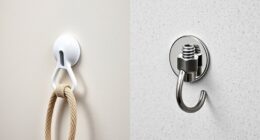If you're looking to achieve a clutter-free lifestyle in 2025, I recommend several effective decluttering tools. "Keep the Memories, Lose the Stuff" helps prioritize sentimental items with a Legacy List. For a structured approach, "The Clutter Diet" is fantastic for motivation and ongoing maintenance. "Decluttering Your Home Workbook" offers practical steps to reflect on your space. Exploring these guides could really transform your journey toward organization, and there's so much more to discover about each tool.
Key Takeaways
- Legacy List Creation: Use the Legacy List approach to prioritize and retain meaningful items while letting go of unnecessary clutter.
- Step-by-Step Workbooks: Utilize workbooks like "Decluttering Your Home Workbook" for structured techniques and self-reflection exercises to guide your decluttering journey.
- Weekly Organization Plans: Implement weekly tasks from guides like "Organize Now!" to break down decluttering into manageable segments, keeping motivation high.
- Emotional Support Communities: Engage with community support through forums or local groups to share experiences and stay accountable in your decluttering efforts.
- Mindfulness Practices: Incorporate mindfulness techniques to thoughtfully evaluate your possessions, fostering emotional connections and easing the decluttering process.
Keep the Memories, Lose the Stuff: Declutter and Downsize Guide
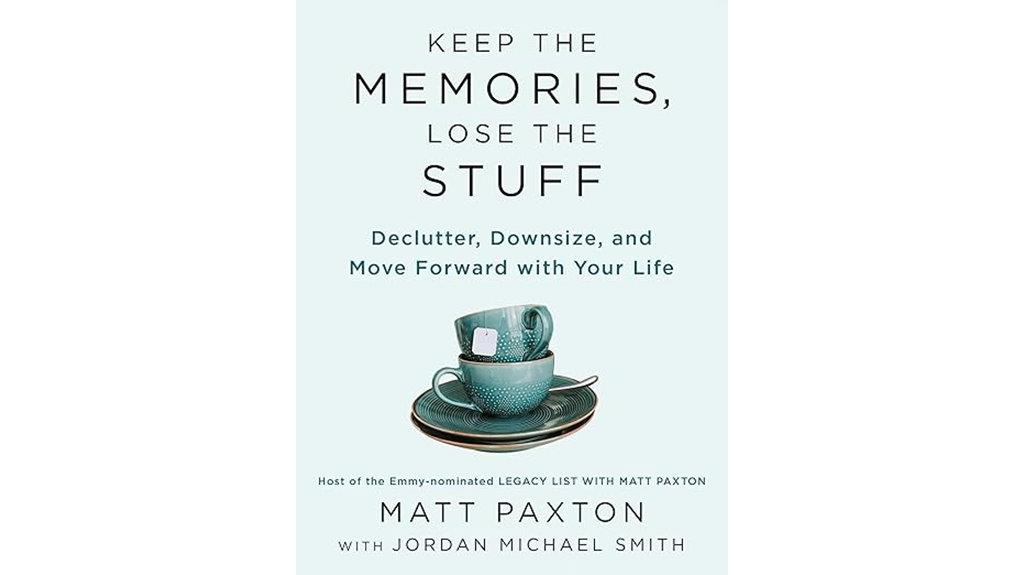
If you're feeling overwhelmed by the clutter in your life, "Keep the Memories, Lose the Stuff" is the perfect guide for you. This book by Matt Paxton offers practical advice for decluttering and downsizing, especially during significant life changes. I love the idea of creating a "Legacy List," which helps me focus on meaningful items while letting go of the rest. Paxton shares real experiences that resonate with anyone struggling to part with sentimental belongings. With tips like dedicating just 10 minutes a day, I've found it easier to tackle my clutter and preserve memories without the weight of unnecessary stuff.
Best For: Individuals feeling overwhelmed by clutter and looking for practical strategies to downsize and preserve meaningful memories.
Pros:
- Provides practical tips that are easy to implement, such as dedicating just 10 minutes a day to decluttering.
- Encourages emotional healing by focusing on meaningful items through the creation of a "Legacy List."
- Shares relatable personal experiences that resonate with readers facing similar challenges.
Cons:
- Some readers may expect more detailed methods for decluttering beyond basic strategies.
- Emotional challenges of parting with belongings may still be difficult for some, despite the guidance provided.
- The focus on a curated legacy may not appeal to those who prefer a more minimalist approach without sentimental attachments.
Decluttering Your Home Workbook: Your Ultimate Guide for a Clutter-Free Life
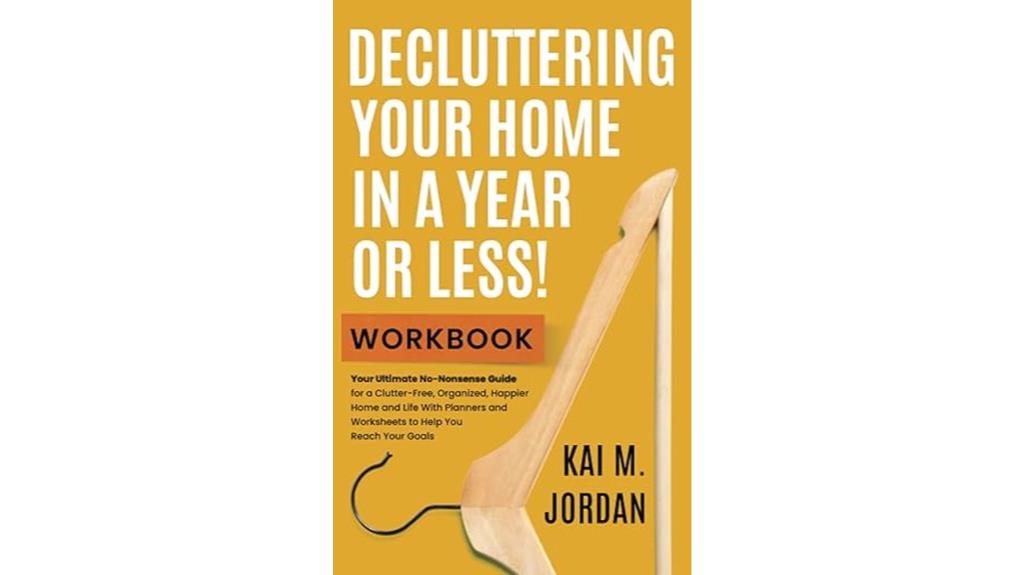
The "Decluttering Your Home Workbook: Your Ultimate Guide for a Clutter-Free Life" is perfect for anyone feeling overwhelmed by clutter, especially those moving to smaller spaces or facing major life changes. This practical guide offers step-by-step techniques and engaging exercises to help you tackle your belongings. I found the self-reflection sections particularly enlightening, pushing me to confront sentimental attachments. While some critiques mention the language might not resonate with everyone, I appreciated the motivation and encouragement throughout. Plus, it encourages donating items, making decluttering a rewarding experience. Overall, it's a valuable tool for anyone ready to embrace a clutter-free life.
Best For: Individuals feeling overwhelmed by clutter, especially those transitioning to smaller living spaces or experiencing major life changes.
Pros:
- Step-by-step techniques make the decluttering process manageable and organized.
- Encouraging self-reflection helps confront sentimental attachments and promotes a healthier mindset towards possessions.
- Donation suggestions provide a rewarding way to declutter while benefiting others and potentially receiving tax deductions.
Cons:
- Some readers may find the language inappropriate or not resonant with their demographics, particularly seniors.
- Certain self-reflection exercises might be perceived as tedious or unnecessary by some users.
- A few critiques mention the writing style and practicality of exercises as areas for improvement.
Organize Now!: A Week-by-Week Guide to Simplify Your Space and Your Life
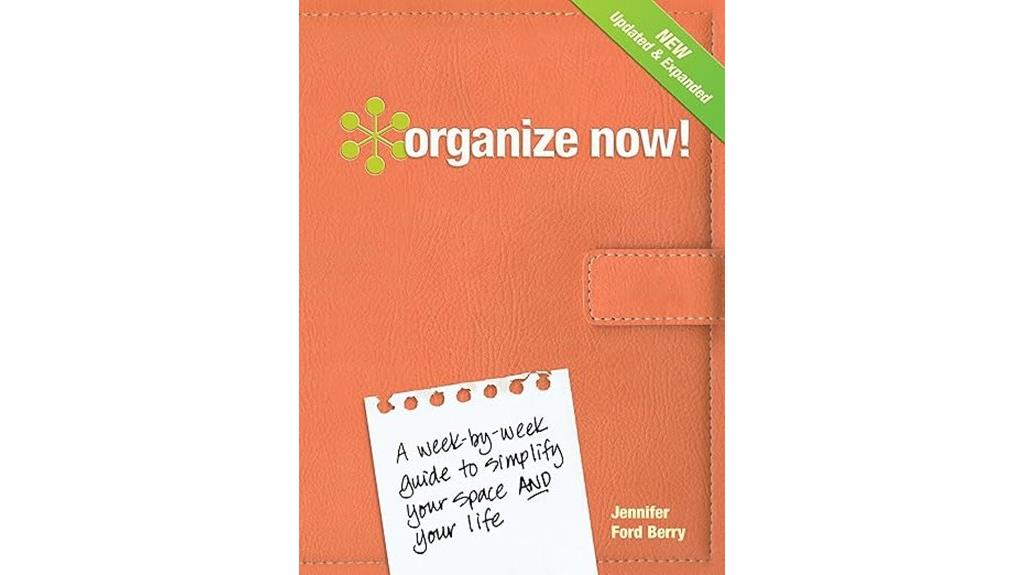
Busy individuals, especially parents juggling multiple responsibilities, will find "Organize Now!: A Week-by-Week Guide to Simplify Your Space and Your Life" an invaluable resource. This 256-page guide breaks down organization into manageable weekly tasks, making it easy to tackle clutter without feeling overwhelmed. I love how it offers checklists for different areas, allowing me to focus on one space at a time. Plus, its action-oriented approach means I can jump right in, saving time. While some sections might feel repetitive, the overall clarity and practicality make it a must-have for anyone seeking to simplify their home and life.
Best For: Busy individuals, particularly parents, looking for practical solutions to declutter and organize their homes effectively.
Pros:
- Action-oriented format with checklists allows for focused, manageable tasks each week.
- Comprehensive coverage of various areas in the home makes it adaptable for different household types.
- Clear and easy-to-use structure helps maintain motivation and progress during decluttering efforts.
Cons:
- Some sections may feel repetitive, lacking unique tips for individual tasks.
- Certain tasks might take longer than a week, potentially leading to frustration.
- A few readers expected more depth and detail in specific areas of organization.
The Clutter Diet: Organizing Your Home and Life
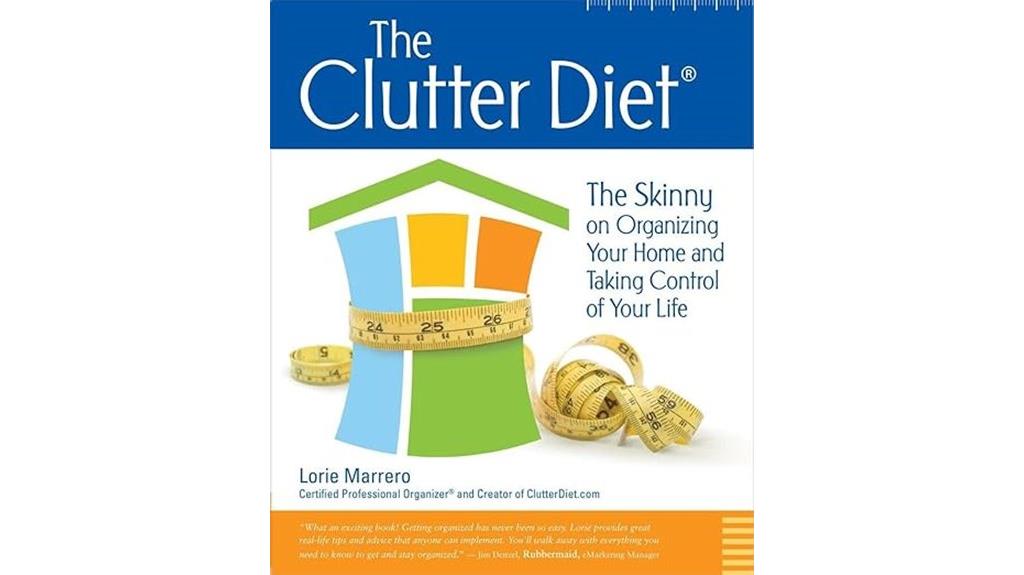
Struggling to maintain an organized home while juggling a hectic lifestyle? "The Clutter Diet: The Skinny on Organizing Your Home and Taking Control of Your Life" by Lorie Marrero offers a practical solution tailored for those who need a structured approach to decluttering. The book breaks down the process into four sections: Getting Motivated, Clutter Prevention, Clutter Reduction, and Maintenance. I found the room-by-room suggestions and downloadable workbooks incredibly helpful. Marrero also dives into the psychology of clutter, guiding me through emotional hurdles. Many readers, including myself, have experienced real progress using her methods. It's a game-changer!
Best For: Individuals seeking a structured approach to decluttering their homes and lives while managing a busy lifestyle.
Pros:
- Practical Guidance: Offers step-by-step strategies and room-by-room suggestions, making decluttering manageable.
- Psychological Insights: Addresses the emotional aspects of clutter, helping readers change their attitudes towards letting go of items.
- Reader Success: Many users report significant improvements in their living spaces and personal satisfaction after applying the methods.
Cons:
- Promotional Focus: Some readers note a strong emphasis on promoting Marrero's online courses throughout the book.
- Limited Novelty: A few critiques mention that the advice may not offer groundbreaking revelations, though it remains effective.
- Gradual Approach: The emphasis on gradual change may not appeal to those looking for quick, immediate results.
Organizing Your Home with SORT and SUCCEED (Book 1)

For anyone feeling overwhelmed by clutter or dealing with ADHD, "Organizing Your Home with SORT and SUCCEED" is an invaluable resource. Darla's engaging style makes it easy to digest the science behind organizing, breaking down tasks into manageable steps. I found her approach liberating, especially as she tackles the emotional side of clutter and emphasizes that motivation isn't a prerequisite for action. By focusing on smaller areas and creating mini-projects, I felt less daunted. Plus, the community support she encourages truly enhances the journey. This book equips you with sustainable strategies to keep clutter at bay, making organizing a lifestyle change.
Best For: Individuals feeling overwhelmed by clutter or those with ADHD seeking practical organizing strategies and community support.
Pros:
- Motivational Writing Style: Engages readers and simplifies the science of organizing into digestible steps.
- Focus on Small Areas: Encourages tackling smaller spaces to avoid feeling overwhelmed, making progress feel achievable.
- Community Support: Provides access to a private Facebook group for encouragement and shared experiences.
Cons:
- Limited Scope: The techniques may not address every unique organizational challenge for all individuals.
- Time Commitment: While mini-projects are manageable, some may still find it challenging to carve out time for organizing.
- Potential Overwhelm with Emotional Aspects: Discussing emotional challenges related to clutter may be difficult for some readers to confront.
A Year to Clear: A Daily Guide to Creating Spaciousness In Your Home and Heart
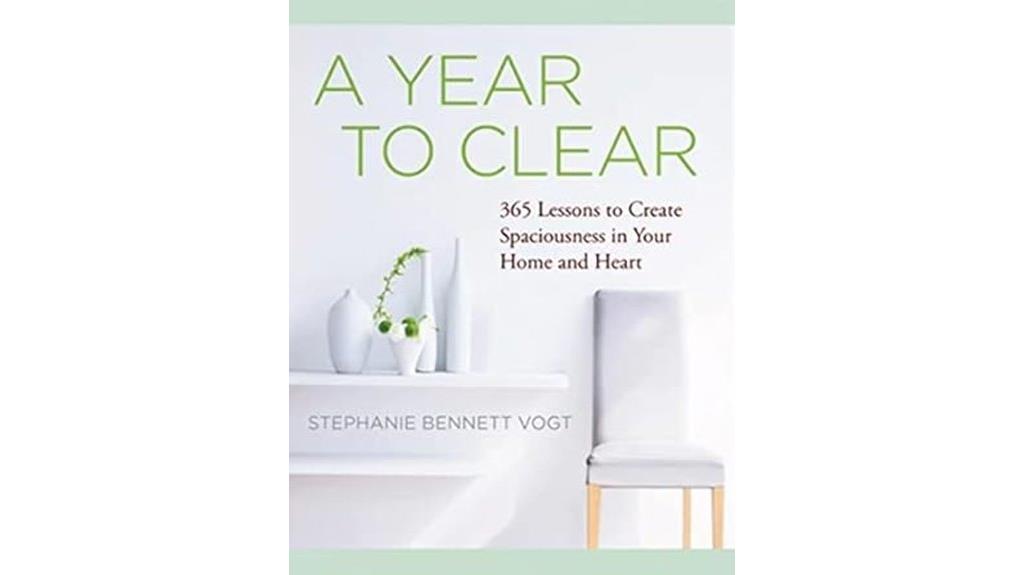
If you're looking to create a sense of spaciousness both in your home and within yourself, "A Year to Clear" might just be the perfect guide for you. This transformative book by Stephanie Bennett Vogt invites you to explore the emotional ties to your belongings while encouraging mindfulness. I found that daily reflections and journaling deepened my understanding of the material and allowed me to let go of attachments holding me back. Unlike other decluttering methods, this approach emphasizes emotional clarity, fostering lasting change. It's a gentle journey that ultimately leads to a more organized and peaceful life.
Best For: Individuals seeking a mindful approach to decluttering that emphasizes emotional connections and promotes long-term change.
Pros:
- Encourages mindfulness: The book fosters a reflective practice that helps readers connect emotionally with their belongings.
- Holistic approach: Unlike traditional decluttering methods, it addresses both physical and mental spaces for comprehensive well-being.
- Sustained engagement: Daily reflections and journaling enhance understanding and retention of the material, leading to lasting transformation.
Cons:
- Slow pace: Some readers may find the gradual approach frustrating if they prefer quicker results.
- New-age elements: Certain concepts may not resonate with everyone, particularly those skeptical of alternative approaches.
- Need for additional structure: Individuals overwhelmed by the process might benefit from combining it with more structured decluttering methods.
Top-To-Bottom Home Organizing Guide
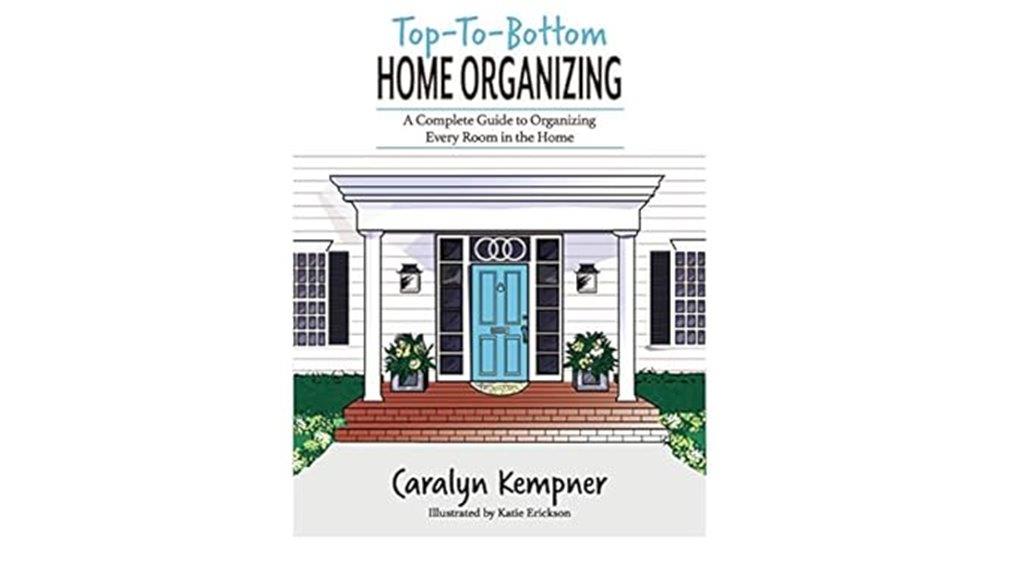
"Top-To-Bottom Home Organizing" is the perfect choice for anyone enthusiastic to transform their living space into an organized haven. Caralyn Kempner's guide covers every room, offering breezy overviews and practical sorting plans. I love how it includes tips for maintaining organization, like the shelf life of makeup and silver storage methods to prevent tarnishing. The hand-drawn illustrations and checklists make concepts easy to grasp. It's ideal for individuals and aspiring professional organizers alike, ensuring nothing important gets overlooked. Whether you're overwhelmed by clutter or just seeking inspiration, this book provides a clear path to achieving a clutter-free home.
Best For: Individuals looking to declutter their homes and aspiring professional organizers seeking a comprehensive guide to effective organization strategies.
Pros:
- Clear, practical advice on organizing various rooms and maintaining systems.
- Hand-drawn illustrations and checklists enhance understanding and usability.
- Updated with current storage products and solutions for diverse living situations.
Cons:
- May not cater to those in smaller living spaces or resistant to acquiring new organizational tools.
- Some readers feel it doesn't offer groundbreaking ideas compared to other organizing resources.
- Overwhelmed individuals might find the sheer volume of information daunting at first.
Factors to Consider When Choosing The Decluttering Tools for a Clutter-Free Year
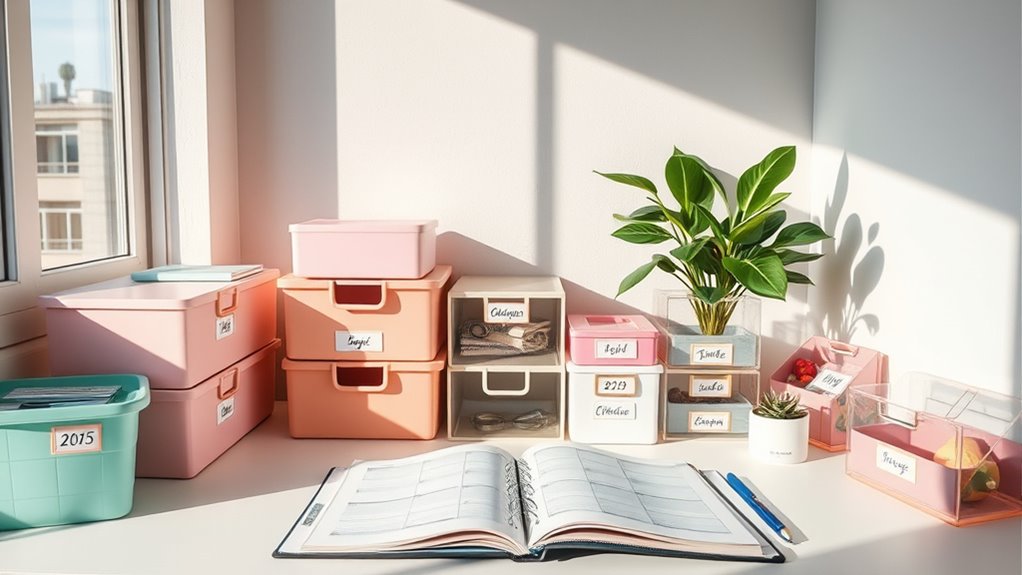
When I'm choosing decluttering tools, I reflect on my personal goals and what motivates me to keep my space organized. It's crucial to evaluate the type of space I'm working with and any emotional attachments I may have to my belongings. Practicality and the support options available can also make a big difference in my decluttering journey.
Personal Goals and Motivation
Understanding my personal goals and motivations for decluttering is essential for choosing the right tools to achieve a clutter-free year. I've realized that clarifying my intentions, whether it's to create more space or reduce stress, sets a solid foundation. Identifying what drives me—be it a life change or simply a desire for organization—helps me stay focused. Setting specific goals, like tackling one room per month or donating a set number of items weekly, makes tracking progress easier and keeps my motivation high. Reflecting on emotional attachments to my belongings guides my decisions on what to keep or let go. Finally, celebrating small victories along the way reinforces my commitment to a clutter-free lifestyle.
Type of Space
While decluttering my space, I quickly realized that the type of area I was working with played a crucial role in the tools I chose. For instance, in my small apartment, I opted for compact, multifunctional solutions that maximized storage without overwhelming the space. Each room, like the kitchen or garage, has unique organizational needs, so I selected specialized tools tailored to those areas. I noticed that open shelving benefited from clear bins, while my closed cabinets needed labeled containers for easy access. Additionally, I considered existing storage solutions, ensuring my new tools complemented them. Finally, I kept the intended use of each space in mind, aligning my decluttering tools with the functional and aesthetic goals I wanted to achieve.
Emotional Attachment Considerations
As I dove deeper into decluttering, I quickly realized that emotional attachments can complicate the process considerably. I found it tough to part with items that held memories or symbolized significant life experiences. To navigate these feelings, I began using a "Legacy List." This approach helps me focus on the stories behind cherished items rather than the items themselves. Understanding the psychological barriers, like guilt or nostalgia, allowed me to confront my emotions, making decisions easier. Mindfulness practices helped me reflect on what truly adds value to my life. I also learned that gradual decluttering, rather than a one-time purge, eased my emotional discomfort, letting me process my feelings and make thoughtful choices about my possessions.
Practicality and Usability
When I began selecting decluttering tools, I quickly realized that practicality and usability were vital for my success. I looked for tools that were easy to use, requiring minimal setup to keep me engaged. Clear, actionable steps like checklists helped me maintain focus and provided a structured approach to organizing. Flexibility was also important; I wanted tools that I could adapt to my unique living situation and preferences. I appreciated motivational elements too, like inspirational quotes and progress tracking, which kept me inspired and accountable. Finally, I sought tools that incorporated psychological insights, helping me understand my emotional attachments to possessions. This combination made my decluttering journey more effective and enjoyable.
Support and Community Options
Finding support and community options can greatly enhance your decluttering journey. Engaging with a support group, whether online or in-person, provides accountability and encouragement, making the process feel less isolating. I've found that connecting with others who share similar goals can spark motivation and offer new strategies for tackling common challenges. Many decluttering resources suggest joining forums or social media groups to foster camaraderie and share experiences. Participating in community-based events or workshops gives you hands-on assistance and expert guidance, which can be invaluable. Plus, the emotional support from these settings helps address psychological barriers, reinforcing positive attitudes towards letting go of possessions. Embrace community; it can truly transform your decluttering efforts!
Frequently Asked Questions
What Are the Best Digital Tools for Decluttering?
When I think about the best digital tools for decluttering, several come to mind. I love using apps like Todoist for task management and Google Drive for organizing documents. Trello helps me visualize my projects, while Evernote keeps my notes tidy. I also rely on digital calendars to schedule decluttering sessions. These tools not only streamline my organization but also make it easier to maintain a clutter-free space. What tools do you find helpful?
How Do I Stay Motivated During the Decluttering Process?
I've often found that staying motivated during decluttering can feel like climbing a mountain. It's tough, but I remind myself of the freedom that comes with a clearer space. To keep my spirits high, I set small goals and celebrate each victory, no matter how tiny. Playing upbeat music helps too! I visualize my ideal space, which fuels my determination. Remember, every step forward gets you closer to a clutter-free life.
Can Decluttering Improve Mental Health?
Absolutely, I've found that decluttering can greatly boost mental health. When I clear out unnecessary items, I feel lighter and more focused. It creates a sense of control and accomplishment. I've noticed that a tidy space reduces my anxiety and enhances my productivity. Plus, it's amazing how much clearer my mind feels in an organized environment. So, if you're feeling overwhelmed, I highly recommend giving decluttering a try for your mental well-being!
What Should I Do With Sentimental Items?
When it comes to sentimental items, I like to think of them as cherished memories waiting to be honored. I start by sorting through them, deciding which truly spark joy and hold meaning for me. I often take photos of those I'm letting go, preserving the memory without the clutter. For the ones I keep, I make sure to display them in a way that brings warmth and happiness to my space.
How Often Should I Declutter My Space?
I find it helpful to declutter my space at least once a season. This way, I can keep things manageable and avoid overwhelming myself. I usually set aside a weekend to go through my belongings, reassessing what I really need and what I can let go of. Additionally, I try to do a quick declutter monthly, focusing on smaller areas. It keeps my environment fresh and my mind clear!
Conclusion
As I wrap up my journey through these decluttering tools, I can confidently say they're like magic wands for transforming chaos into calm! With the right resources, you can conquer clutter and create a serene space that feels like a refreshing change. So, if you're ready to embrace a clutter-free year in 2025, grab one or more of these tools and let the organizing adventure begin! Your dream home is just a declutter away!









